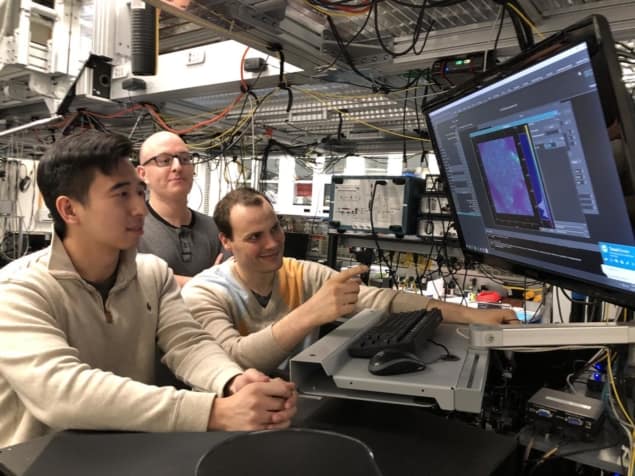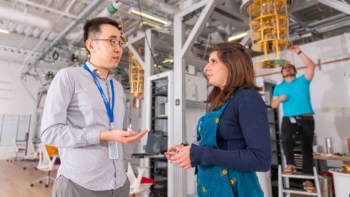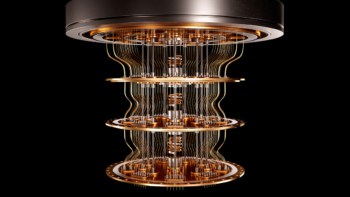
All particles have a wave-like nature, but in the everyday, macroscopic world their quantum behaviour is hidden thanks to interactions with their surroundings – for example via gravity, electromagnetism or heating. Such interactions also mean that a quantum system will quickly lapse into classical behaviour – a process known as decoherence – unless it is isolated from its environment. Scientists at the University of Chicago have now developed a simple strategy that allows quantum systems to fend off decoherence for 10 000 times longer. The technique, which has been tested on solid-state qubits (quantum bits) made from silicon carbide defects, could advance many areas of quantum science, including quantum computing, communications and sensing.
Quantum computing has made significant progress in recent years, and in 2019 researchers at Google unveiled a basic quantum processor that performs certain tasks faster than a conventional supercomputer. In practice, however, the problem of decoherence, which destroys any stored quantum information, must still be overcome before such devices become widespread and able to tackle significant real-world problems. This is because quantum computers work by exploiting the ability of a quantum particle to be in a superposition of two or more states at the same time, and the fragile nature of these superpositions makes them easy to destroy and hard to control.
Silicon carbide point defects
A team of researchers led by David Awschalom recently discovered that silicon carbide – a material already widely employed in high-power electronics – hosts point defects that might help solve this problem. Such defects are attractive because their decoherence time is much longer than the time required to perform a logical operation in a quantum processor – even at room temperature. The defects also contain electron spin states that can be controlled as qubits and manipulated using light.
In their earlier work, the researchers studied a specific crystal structure of silicon carbide known as 4H-SiC that contains naturally-occurring defects called divacancies. These defects correspond to a missing silicon atom next to a missing carbon atom in the material’s crystal lattice, and they are similar to nitrogen-vacancy centres in diamond (which also boast long decoherence times and have already been used as qubits that can be controlled by light at room temperature). Both types of defect form a multi-electron system with a net angular momentum, or spin, that can be aligned either parallel (“1”) or antiparallel (“0”) to an applied magnetic field.
A new trick
Researchers in several groups have explored different strategies for extending the decoherence times of this and other systems. One common approach is to physically isolate the system from its noisy surroundings. Another technique is to make all the materials as pure as possible. Neither task is easy in practice, and Awschalom and colleagues have now devised a very different protocol.
Instead of trying to eliminate noise in the systems’ surroundings, study lead author Kevin Miao says that he and his colleagues, in effect, “trick” the system into thinking that the noise isn’t there. They achieved this by applying an alternating magnetic field to the 4H-SiC divacancy in addition to the electromagnetic pulses (oscillating magnetic fields at microwave frequencies, in this case) employed to control the spin states in quantum systems. These pulses cause the spin of the divacancy to oscillate between its two qubit states (via electron spin resonance), and this oscillation can then be used to “write” quantum information to the sample.
By precisely tuning their additional magnetic field, Awschalom’s team demonstrated that they could rapidly rotate the electron spins in the system and allow it to “tune out” surrounding noise. “It’s like sitting on a merry-go-round with people yelling all around you,” Miao explains. “When the ride is still, you can hear them perfectly, but if you’re rapidly spinning, the noise blurs into a background.”
Divacancy ignores environmental noise
The new technique allowed the researchers to increase the decoherence time of the system to 22 milliseconds – four orders of magnitude longer than it would be without their modification, and far longer than any previously reported electron spin system. This is because the 4H-SiC divacancy, under the influence of the alternating magnetic field, is able to almost completely “ignore” some forms of temperature fluctuations, physical vibrations and electromagnetic noise, all of which are the bane of quantum coherence.
According to Awschalom, the approach creates a pathway to scaling up the numbers of qubits in a quantum processor. “It should make storing quantum information in electron spin practical,” he explains. “Extended storage times will enable more complex operations in quantum computers and allow quantum information transmitted from spin-based devices to travel longer distances in networks.”

Silicon carbide LEDs make bright single photon sources
The researchers say their approach could also be tested in quantum systems other than 4H-SiC divacancies, such as superconducting quantum bits and molecular quantum structures.
“There are a lot of candidates for quantum technology that were pushed aside because they couldn’t maintain quantum coherence for long periods of time,” Miao stated in a press release issued by the University of Chicago. “Those could be re-evaluated now that we have this way to massively improve coherence.” The best part, he adds, is that “it’s incredibly easy to do. The science behind it is intricate, but the logistics of adding an alternating magnetic field are very straightforward.”
The new coherence protection technique is detailed in Science.



